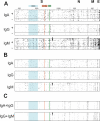Peptide microarrays coupled to machine learning reveal individual epitopes from human antibody responses with neutralizing capabilities against SARS-CoV-2
- PMID: 35320064
- PMCID: PMC9009950
- DOI: 10.1080/22221751.2022.2057874
Peptide microarrays coupled to machine learning reveal individual epitopes from human antibody responses with neutralizing capabilities against SARS-CoV-2
Abstract
The coronavirus SARS-CoV-2 is the causative agent for the disease COVID-19. To capture the IgA, IgG, and IgM antibody response of patients infected with SARS-CoV-2 at individual epitope resolution, we constructed planar microarrays of 648 overlapping peptides that cover the four major structural proteins S(pike), N(ucleocapsid), M(embrane), and E(nvelope). The arrays were incubated with sera of 67 SARS-CoV-2 positive and 22 negative control samples. Specific responses to SARS-CoV-2 were detectable, and nine peptides were associated with a more severe course of the disease. A random forest model disclosed that antibody binding to 21 peptides, mostly localized in the S protein, was associated with higher neutralization values in cellular anti-SARS-CoV-2 assays. For antibodies addressing the N-terminus of M, or peptides close to the fusion region of S, protective effects were proven by antibody depletion and neutralization assays. The study pinpoints unusual viral binding epitopes that might be suited as vaccine candidates.
Keywords: COVID-19; SARS CoV-2; immunoassays; machine learning; neutralizing antibodies; peptide arrays; serology.
Conflict of interest statement
No potential conflict of interest was reported by the author(s).
Figures





Similar articles
-
High-Resolution Linear Epitope Mapping of the Receptor Binding Domain of SARS-CoV-2 Spike Protein in COVID-19 mRNA Vaccine Recipients.Microbiol Spectr. 2021 Dec 22;9(3):e0096521. doi: 10.1128/Spectrum.00965-21. Epub 2021 Nov 10. Microbiol Spectr. 2021. PMID: 34756082 Free PMC article.
-
Comprehensive characterization of the antibody responses to SARS-CoV-2 Spike protein finds additional vaccine-induced epitopes beyond those for mild infection.Elife. 2022 Jan 24;11:e73490. doi: 10.7554/eLife.73490. Elife. 2022. PMID: 35072628 Free PMC article.
-
Antibody Response against SARS-CoV-2 and Seasonal Coronaviruses in Nonhospitalized COVID-19 Patients.mSphere. 2021 Feb 24;6(1):e01145-20. doi: 10.1128/mSphere.01145-20. mSphere. 2021. PMID: 33627511 Free PMC article.
-
Evaluation of Spike Protein Epitopes by Assessing the Dynamics of Humoral Immune Responses in Moderate COVID-19.Front Immunol. 2022 Mar 18;13:770982. doi: 10.3389/fimmu.2022.770982. eCollection 2022. Front Immunol. 2022. PMID: 35371042 Free PMC article.
-
Comprehensive mapping of SARS-CoV-2 peptide epitopes for development of a highly sensitive serological test for total and neutralizing antibodies.Protein Eng Des Sel. 2022 Feb 17;35:gzab033. doi: 10.1093/protein/gzab033. Protein Eng Des Sel. 2022. PMID: 35174857 Free PMC article.
Cited by
-
Bioinformatic elucidation of conserved epitopes to design a potential vaccine candidate against existing and emerging SARS-CoV-2 variants of concern.Heliyon. 2024 Jul 23;10(15):e35129. doi: 10.1016/j.heliyon.2024.e35129. eCollection 2024 Aug 15. Heliyon. 2024. PMID: 39157328 Free PMC article.
-
Direct lipid interactions control SARS-CoV-2 M protein conformational dynamics and virus assembly.bioRxiv [Preprint]. 2024 Nov 5:2024.11.04.620124. doi: 10.1101/2024.11.04.620124. bioRxiv. 2024. PMID: 39574576 Free PMC article. Preprint.
-
T-Cell Epitope Mapping of SARS-CoV-2 Reveals Coordinated IFN-γ Production and Clonal Expansion of T Cells Facilitates Recovery from COVID-19.Viruses. 2024 Jun 22;16(7):1006. doi: 10.3390/v16071006. Viruses. 2024. PMID: 39066169 Free PMC article.
-
The BBIBP-CorV inactivated COVID-19 vaccine induces robust and persistent humoral responses to SARS-CoV-2 nucleocapsid, besides spike protein in healthy adults.Front Microbiol. 2022 Nov 4;13:1008420. doi: 10.3389/fmicb.2022.1008420. eCollection 2022. Front Microbiol. 2022. PMID: 36406456 Free PMC article.
-
Assessment of Immunogenic and Antigenic Properties of Recombinant Nucleocapsid Proteins of Five SARS-CoV-2 Variants in a Mouse Model.Viruses. 2023 Jan 13;15(1):230. doi: 10.3390/v15010230. Viruses. 2023. PMID: 36680269 Free PMC article.
References
MeSH terms
Substances
LinkOut - more resources
Full Text Sources
Other Literature Sources
Medical
Miscellaneous
